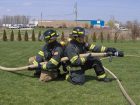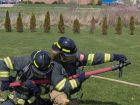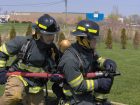
Features
Structural
Training
Back to Basics: Back to Basics celebrates 10 years
This year, Back to Basics has reached a milestone. We are entering our 10th year of publication. When I look back on the past 10 years, I am amazed at how much we have covered. I must admit that I never thought this column would last five years, let alone 10. For our 10-year anniversary, I am going to recap some of my favourite articles from over the years that garnered attention within the Canadian fire service.
February 21, 2018
By Mark van der Feyst
We are going to start with the very first article I ever wrote – the one that started it all: nozzle management.
■ Nozzle management 101: August 2008
With the advent of the pistol grip nozzle, came poor and sloppy nozzle handling skills. Every firefighter became a cowboy or a six-shooter, holding the nozzle at their hip to direct the stream of water (Photo 2). I have seen everybody from new recruits to seasoned veterans hold a pistol grip nozzle in this fashion. The nozzle with no pistol grip, offers the same water delivery method as the pistol grip does. The pistol grip nozzle was designed to make holding a nozzle easier for one person, but one person should never operate a nozzle alone. The pistol grip nozzle is a good nozzle and offers many advantages. We have forgotten the basics of handling a nozzle correctly and efficiently because of the pistol grip handle being provided. If we stick to the basics of fire fighting, or in this case, holding and operating a nozzle correctly, we will maximize our fire suppression efforts.
Handling a hoseline requires at least two people. The reactionary forces produced by the movement of water exiting the nozzle works against the person who is handling it. This is why we always want to have at least two people handling a hoseline. As depicted in photo 2, the natural tendency is to hold the nozzle by its pistol grip handle to operate the nozzle. Look at how close the nozzle is to the firefighter’s body. This firefighter will not have the ability to move the nozzle around to be effective. In order for firefighters to move the nozzle up, down, left or right, they will have to move their whole body. Chances are the person at the nozzle is probably taking all the nozzle reaction because backup is not doing their job. This increases the ineffectiveness of handling or directing the nozzle up, down, left or right. The firefighter will have to move their whole body as well as control the nozzle reaction by holding the nozzle close to his body.
Nozzle reaction is present with any type of nozzle being used. The amount of nozzle reaction produced will depend upon the amount of water flowing. The more water and pressure being pumped, the greater the nozzle reaction. A single person cannot sustain holding a nozzle for a long period of time without fatigue settling in quickly due to the reactionary forces fighting against them. This is where the backup firefighter comes into play. The backup has an important job to do, and that job is to take away the nozzle reaction from off the nozzle firefighter. By doing this, the nozzle firefighter will have the ability and freedom to control and direct the nozzle.
So how do we accomplish this? We accomplish proper nozzle management by going back to the basics. Whether you have a pistol grip nozzle or just a plain nozzle, going back to the basics can be accomplished and will work every time. In photo 3, we can see the foundation of proper nozzle management. Look at the nozzle in relation to the firefighter. The nozzle is about an arm’s length away from the firefighter. When his arm is fully extended, the firefighter should be able to grip the bale of the nozzle in the closed position. With the nozzle in this position, the firefighter will be able to direct the stream of water in any direction he wishes to do so. To move the stream up, down, left or right, will be a simple matter of just moving the nozzle and not the whole body. Once the nozzle is open, the left hand can move onto the hose just behind the coupling to aid in the control of directing the nozzle.
Next notice the hose in the arms of the first firefighter. The hose is right up under his armpit. The firefighter’s right hand is on the hose holding the hose close to his body. He is resting his right arm on his right leg to help ease the burden of holding the hose line. This will maximize and extend the duration of handling the hose line. From this position, the firefighter is able to flow water, direct it in any direction and advance it when needed. With the nozzle out in front of the firefighter as shown in photo 3, the firefighter will be able to hold onto the hose when the hose line is being pulled out. If the firefighter in photo 1 is holds the nozzle by its pistol grip handle while the hoseline is being pulled out by his crew who is zealous to get the hoseline out, he will lose the nozzle. If a firefighter holds the nozzle as shown in photo 3, and the same zealous crew was pulling the hose line out, he or she will be able to hold onto the nozzle and not lose it, another point for safety. Advancing a hose line from this position is easier and more effective and is another topic for discussion.
The backup firefighter in photo 3 has an important job. His is supporting the nozzle firefighter. We teach new recruits to support nozzle firefighters by putting one arm on their back and one foot behind the nozzle firefighter’s foot as per the IFSTA Essentials of Fire Fighting. What does this do? It makes the picture look pretty, but is accomplishing absolutely nothing. In photo 3, look at the backup firefighter’s position in relation to the nozzle firefighter. He has his whole body supporting the member at the nozzle and has both hands holding the hose. By doing this, he is taking away the nozzle reaction from the nozzle firefighter, while providing support at the same time. (When it comes time to discuss hoseline advancement, this position is very crucial in the drive of the hoseline). Backup has to ensure that hose remains in a straight line. By keeping the hose in a straight line, the backup firefighter is ensuring the nozzle reaction stays with him. This will give the nozzle firefighter the ability to direct the nozzle. Once the hose line is not kept straight, the nozzle reaction is transferred back to the person at the nozzle. This is crucial when the nozzle firefighter is directing the stream left, right, up or down. Whichever direction the nozzle firefighter moves the nozzle, the backup man has to synchronize their movements to maintain a straight hoseline. Notice how straight the hoseline is in photo 3.
So far, we have shown pictures with a 1 ¾-inch handline. This size of handline is easier to handle versus a 2 ½-inch handline. The techniques discussed above also work for the 2 ½-inch handline. In photo 1, a different technique is being used from the backup firefighter to support the nozzle firefighter. By facing backward and putting his whole back against the nozzle firefighter, the backup member is able to support the member at the nozzle, extend his endurance in holding the hoseline and will be able to keep watch on the conditions behind them at all times. Another technique for the 2 ½-inch handline, is for the nozzle firefighter to put one of his or her knees on the hose (using their whole body weight) while keeping the same amount of hose in front. This is helpful when one firefighter must flow a 2 ½-inch handline by themselves for a short duration of time while waiting for their partner.
By going back to the basics with our nozzle management, we will produce better-trained firefighters who will be more effective in fire stream application.
Mark van der Feyst is a 14-year veteran of the fire service. He works for the City of Woodstock Fire Department in Ontario. Mark instructs in Canada, the United States and India E-mail Mark at Mark@FireStarTraining.com
Print this page
Advertisement
- Mutual aid: How 3 departments are working together to meet community needs
- Kids and Arson: How a Canadian city stopped fire-setting youth, part 2


